Insights into Diagnosing Amyloid Cardiomyopathy
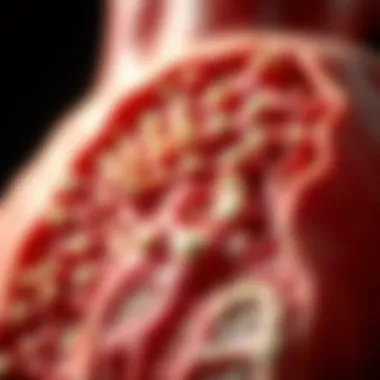
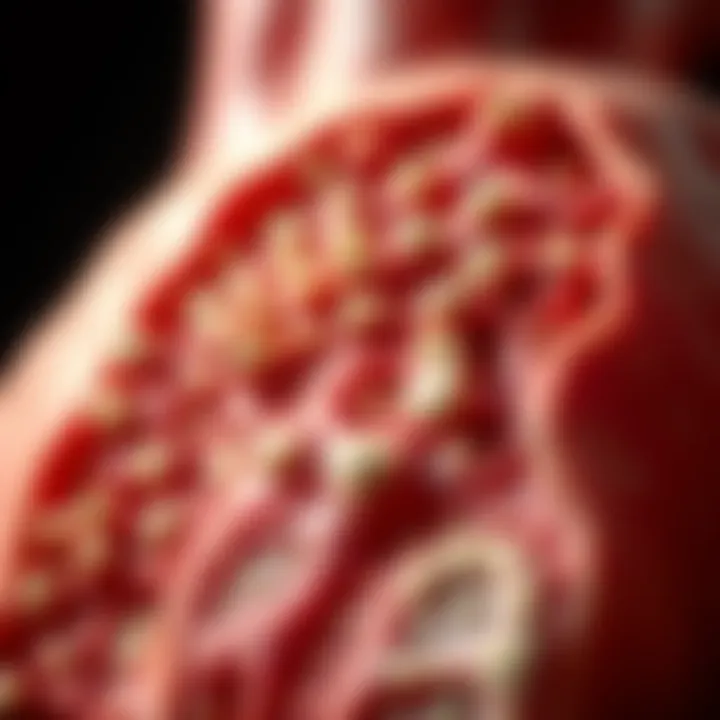
Intro
Amyloid cardiomyopathy (ACM) is not just a term that rolls off the tongue; it represents a complex and often misdiagnosed condition that can lead to significant health issues. Understanding this ailment requires delving into its pathophysiology, clinical manifestations, and relevant diagnostic modalities that are vital for effective patient management. The heart is a finicky organ, and when amyloid proteins infiltrate its tissues, the consequences can range from mild irregularities to severe heart failure.
Here, we embark on a journey through the intricacies of diagnosing ACM, shedding light on the multifaceted approaches employed by clinicians. From imaging techniques to serum biomarkers, we explore how early detection can make all the difference. In a world where knowledge is power, let's equip ourselves with comprehensive insights into this challenging arena of cardiology.
Understanding Amyloid Cardiomyopathy
Understanding amyloid cardiomyopathy is pivotal for both clinicians and patients alike, as it lays the groundwork for a comprehensive exploration of this complex cardiac condition. This heart disease arises from an abnormal protein deposition that disrupts normal heart function. The significance of grasping the nuances of amyloid cardiomyopathy cannot be overstated, particularly in its early detection and management. Early recognition can greatly influence the overall outcomes and help mitigate the adverse effects of this condition.
Considering how amyloid cardiomyopathy often masquerades as other cardiac diseases, it becomes crucial to recognize its distinguishing features. The interplay between amyloidosis and the heart’s structural and functional impairment can lead to a cascade of symptoms that are easily overlooked or misdiagnosed. Thus, possessing a well-rounded understanding enables healthcare professionals to make informed decisions regarding diagnosis and therapeutic strategies.
Moreover, this familiarity empowers patients, giving them the tools to advocate for their health. Armed with knowledge about the warning signs and potential implications, individuals can seek timely medical advice and thus improve their quality of life. In essence, appreciating the intricacies of amyloid cardiomyopathy isn't just beneficial—it's essential.
Definition and Overview
Amyloid cardiomyopathy refers to the type of heart disease caused by the abnormal accumulation of amyloid proteins in heart tissue. The condition often leads to heart failure and arrhythmias through the stiffening of heart muscles, ultimately compromising the heart's ability to pump blood effectively. The protein deposits are associated with various types of amyloidosis, thus presenting distinct clinical challenges and requiring a nuanced understanding of each type.
Types of Amyloidosis
Understanding the specific types of amyloidosis is crucial because the underlying cause and treatment options can differ significantly.
AL Amyloidosis
AL amyloidosis, also known as primary amyloidosis, is a condition in which the body produces abnormal light chains from plasma cells, leading to protein buildup. The key characteristic of AL amyloidosis is that it commonly occurs in association with plasma cell disorders, like multiple myeloma. Its relevance to this article lies in its prevalence as a cause of cardiac amyloidosis and the urgency it introduces in diagnosis and management.
A unique feature of AL amyloidosis is its potential to involve multiple organs, including the heart, kidneys, and nervous system, thus complicating treatment options. However, advancements in therapies like chemotherapy have proven effective in addressing the root causes and helping many patients regain a measure of normalcy in their lives.
ATTR Amyloidosis
ATTR amyloidosis, or transthyretin amyloidosis, involves deposits of the transthyretin protein and typically presents a different clinical scenario compared to AL amyloidosis. Its hallmark is that it can be hereditary (familial form) or acquired due to aging (wild-type form). The implication of ATTR amyloidosis in this article cannot be ignored, as it's emerging as a leading cause of heart failure in the elderly population.
Moreover, a unique aspect of ATTR amyloidosis is that it can remain undiagnosed for many years due to its subtle overlapping symptoms with age-related cardiac issues. These characteristics underscore the importance of raising awareness and understanding how ATTR can contribute to amyloid cardiomyopathy, particularly amongst older adults.
Other Rare Types
There are other rare forms of amyloidosis, such as those associated with chronic inflammatory conditions, dialysis-related amyloidosis, and hereditary variants. These less common types also contribute to the broader understanding of amyloid cardiomyopathy.
A key characteristic of these rare types is that they often manifest in unique populations, necessitating tailored approaches to diagnosis and treatment. Their importance in this discussion centers around the comprehensive understanding they provide, ensuring healthcare professionals maintain a vigilant eye on symptoms that could signify the presence of amyloid deposits.
In summary, understanding the diverse types of amyloidosis sets a foundation for a more robust comprehension of amyloid cardiomyopathy and emphasizes the need for tailored diagnostic approaches. This diversity illustrates the importance of a nuanced approach to diagnosis, management, and ultimately, patient care.
Pathophysiology of Amyloid Deposits
Understanding the pathophysiology of amyloid deposits is crucial for delving into amyloid cardiomyopathy. At the heart of this condition, the abnormal protein accumulation is not merely a cellular nuisance; it drives the entire clinical syndrome. By examining how these deposits form and affect cardiac function, we gain insights that can pave the way for more targeted interventions and improved patient outcomes.
Mechanism of Amyloid Formation
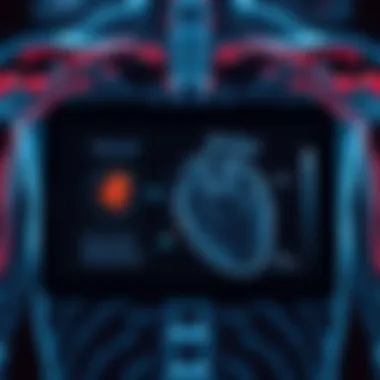
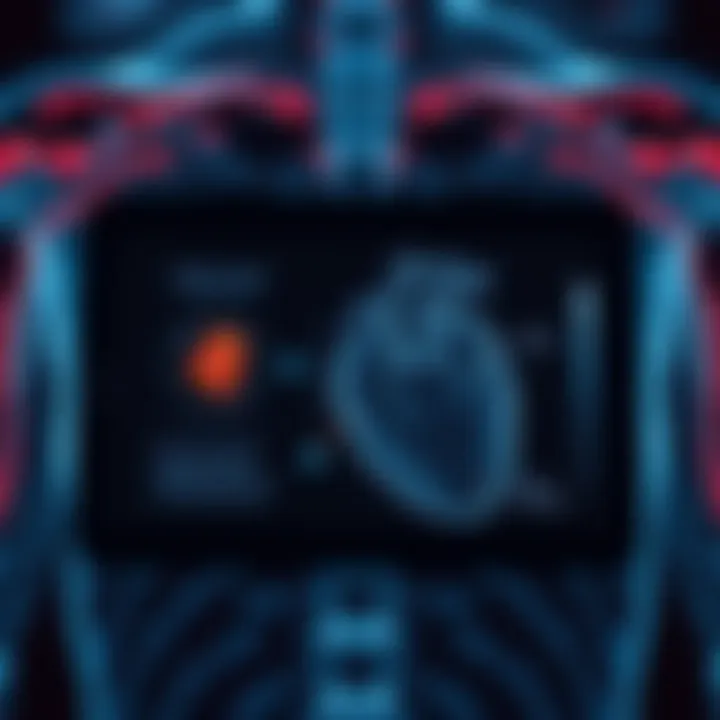
The formation of amyloid is a complex biochemical event that typically occurs through misfolding of proteins. These proteins aggregate, leading to fibril formation, which is at the core of amyloid deposits. Two predominant types of amyloidosis, AL and ATTR, illustrate the varied origins of these deposits:
- AL Amyloidosis: This type arises from monoclonal light chains produced by plasma cells that have underwent neoplastic transformation. Here, the misfolding and aggregation of these light chains lead to fibril formation.
- ATTR Amyloidosis: This involves the misfolding of transthyretin (TTR), a protein mainly produced in the liver. There are two forms—wild type, often seen in older adults, and hereditary forms linked to specific genetic mutations.
Understanding the underlying mechanisms is not a trivial pursuit. Each route of amyloid formation carries unique implications regarding treatment and prognosis. The identification of these pathways allows clinicians to better tailor their approaches, facilitating a more nuanced understanding of the patient's underlying disease.
Impact on Cardiac Function
The impact of amyloid deposits on cardiac function is profound and multifaceted. These deposits primarily infiltrate the myocardial tissue, disrupting normal cardiac function in several significant ways:
- Diastolic Dysfunction: The amyloid fibrils lead to stiffening of the heart muscle. This stiffness reduces the heart's ability to relax properly, leading to diastolic heart failure. Patients may experience symptoms like shortness of breath, particularly during exertion.
- Reduced Contractility: As the disease progresses, not only does the heart become stiff, but its ability to contract effectively diminishes as well. This can result in a reduced ejection fraction, one of the critical parameters assessing cardiac function.
- Conduction Abnormalities: The infiltration also affects the electrical pathways of the heart, resulting in arrhythmias. These irregular rhythms can be dangerous and contribute to increased morbidity.
In summary, the impact of amyloid deposits extends beyond mere structural changes; it creates a ripple effect that compromises the heart's overall functionality. This understanding is integral to framing the diagnosis and treatment options, allowing healthcare professionals to focus on specific therapeutic strategies aimed at both the amyloid deposition and the resulting functional consequences.
"The diagnosis of amyloid cardiomyopathy requires a high index of suspicion, as the signs and symptoms can easily be mistaken for more common conditions such as heart failure or hypertensive heart disease."
Clinical Presentations
Understanding the clinical presentations of amyloid cardiomyopathy is pivotal for both timely diagnosis and appropriate management. By recognizing how the condition manifests in patients, healthcare professionals can differentiate it from other cardiac diseases and implement strategies for improved outcomes. Gettin' a grip on the symptoms and risk factors associated with amyloid cardiomyopathy is the first step in ensuring effective treatment and patient care.
Symptoms and Signs
The signs and symptoms of amyloid cardiomyopathy often creep in gradually, making early recognition a challenge. Patients may not exhibit obvious indicators initially, which leads to misdiagnosis or delayed treatment. The most common symptoms to watch for include:
- Shortness of Breath: Many individuals report difficulty catching their breath during physical activity or even at rest as the condition progresses.
- Fatigue: A nagging sense of fatigue can become a constant thorn in the side of affected individuals, often misattributed to aging or lifestyle factors.
- Swelling in the Legs and Ankles: Patients complain about weight in their limbs due to fluid retention caused by heart dysfunction.
- Irregular Heartbeat: Arrhythmias may signal cardiac involvement, further complicating the clinical picture.
- Chest Pain: Some patients report discomfort, which can be mistaken for angina or other cardiac conditions.
- Dizziness or Fainting: These distressing experiences can occur, especially upon exertion or sudden position changes.
Understanding this cluster of symptoms can save lives, as misinterpretation might lead a patient and their healthcare provider on a wild goose chase, ultimately resulting in delayed care.
Risk Factors
Identifying the risk factors associated with amyloid cardiomyopathy can shed light on who is more susceptible to developing the condition. While anyone can potentially be affected, certain groups stand out. Here are the key risk factors to consider:
- Age: Amyloid cardiomyopathy predominantly manifests in older adults, typically over 60.
- Genetic Predisposition: Some individuals may inherit genetic mutations that heighten their risk, particularly those associated with ATTR amyloidosis, which can run in families.
- Prior Conditions: Conditions such as multiple myeloma can increase the likelihood of AL amyloidosis, while other diseases may predispose a patient to amyloid protein accumulation in the heart.
- Gender: It appears that men have a slightly higher risk, particularly for ATTR amyloidosis.
Being cognizant of these risk factors allows healthcare professionals to approach screening and evaluation more strategically. Rather than relying solely on symptoms that may be common across a range of cardiac issues, understanding these associated traits creates a more nuanced framework for diagnosis.
Diagnostic Approach
In the realm of amyloid cardiomyopathy, a precise and methodical diagnostic approach is paramount for effective patient management. Early diagnosis enables timely interventions which may significantly alter the disease course. The key components of this diagnostic process encompass a comprehensive strategy involving clinical evaluation, imaging techniques, invasive procedures, and the identification of specific biomarkers. Addressing each element with due diligence not only reinforces understanding but also ensures that healthcare professionals can provide patients with the best possible outcomes.
Initial Evaluation
The foundation of diagnosis lies in the initial evaluation, where a clinician gathers critical information through patient history and physical examination. Symptoms like fatigue, shortness of breath, and edema can often lead clinicians down the path of amyloid cardiomyopathy suspicion. This stage is essential, as nuances in patient-reported symptoms, family history, and past medical events can provide valuable hints. Furthermore, performing a detailed cardiac examination to identify signs such as heart murmurs can be telling. Importantly, clinicians are advised to maintain a high index of suspicion when encountering unexplained heart failure in older patients.
Role of Imaging Techniques
Diagnostic imaging is an integral facet in the diagnosis of amyloid cardiomyopathy. Various modalities come into play, each with its unique strengths.


Echocardiography
Echocardiography stands out as a frontline non-invasive technique that sheds light on cardiac structure and function. Specifically, it allows for visualization of left ventricular hypertrophy, a hallmark of amyloid infiltration. This method is cost-effective and widely accessible, making it a popular choice among practitioners. The unique feature of echocardiography is its ability to provide real-time images, helping in the assessment of diastolic dysfunction. However, it may fall short in differentiating between types of amyloidosis, thus requiring further diagnostic exploration.
Cardiac MRI
Cardiac MRI offers a more detailed perspective when it comes to evaluating myocardial tissue. Characteristically, it excels in assessing myocardial edema and fibrosis. This imaging modality presents as a beneficial alternative when echocardiography results remain inconclusive. One distinctive advantage of cardiac MRI is its capacity to identify specific patterns indicative of amyloidosis, such as late gadolinium enhancement. Nonetheless, access to MRI facilities can be limited, and factors such as patient weight or specific metal implants may restrict eligibility for some individuals.
Nuclear Imaging
Nuclear imaging presents another layer of diagnostic capability, particularly through the use of technetium-99m-labeled tracers. This technique focuses on myocardial perfusion and viability, indicating not just structural changes but also functional ones. One key characteristic of nuclear imaging is its ability to differentiate ATTR amyloidosis from AL amyloidosis, aiding in tailoring therapeutic strategies accordingly. Yet, the challenges linked with this method include exposure to radioactive materials and the lengthy setup involved.
Biopsy and Histopathology
A definitive diagnosis often necessitates a biopsy, where tissue samples are scrutinized microscopically for amyloid deposits. Common sites for biopsy include the heart, abdominal fat, and bone marrow. Histopathological examination remains the gold standard, revealing characteristic staining patterns that confirm the presence of amyloid. While the procedure is generally safe, it must be thoughtfully considered against the patient's overall condition and anatomical accessibility.
Biomarkers in Diagnosis
Biomarkers have become pivotal in the diagnostic landscape of amyloid cardiomyopathy, providing additional layers of diagnostic precision.
Serum Amyloid P Component
The Serum Amyloid P Component (SAP) serves as a critical marker for the presence of amyloid deposits in the body. Unique in its capacity to bind specifically to amyloid fibrils, it offers insights into systemic involvement. This marker can assist in monitoring disease progression and treatment response. Despite its benefits, the interpretation can be complex, as elevated levels may not exclusively indicate cardiac involvement, hence necessitating correlation with clinical findings.
Troponins and Natriuretic Peptides
Troponins and natriuretic peptides are biomarkers that hold significant weight in evaluating cardiac function and can indicate myocardial stress. High levels of troponins suggest cardiac injury, while natriuretic peptides serve as markers for heart failure. Their role in amyloid cardiomyopathy diagnosis lies in quantifying cardiac involvement and guiding treatment decisions. However, these markers alone cannot confirm amyloidosis and should be interpreted alongside imaging and histological results.
Differential Diagnosis
Differential diagnosis plays a pivotal role in the assessment of amyloid cardiomyopathy. Given the often ambiguous presentation of this condition, distinguishing it from other cardiac pathologies becomes paramount. Accurate differentiation not only impacts treatment decisions but also shapes the overall prognosis and quality of life for patients.
The intricacy of amyloid cardiomyopathy stems from its mimicry of other heart diseases. Healthcare professionals must scrutinize clinical presentations closely, as symptoms may overlap significantly with other conditions like hypertensive heart disease or restrictive cardiomyopathy. An astute awareness of these differences can lead to timely interventions and tailored management plans.
Conditions Mimicking Amyloid Cardiomyopathy
Various conditions can present similarly to amyloid cardiomyopathy, making the diagnostic process complex. Some of these include:
- Hypertensive Heart Disease: Patients may present with left ventricular hypertrophy, which can be confused with the thickened walls characteristic of amyloidosis.
- Dilated Cardiomyopathy: This condition may also result in heart failure; however, the underlying etiology differs greatly from that of amyloidosis.
- Sarcoidosis: Granulomatous inflammation can lead to cardiac involvement that mimics amyloid deposition.
- Restrictive Cardiomyopathy: Often characterized by impaired filling of the heart due to stiffness, restrictive cardiomyopathy can present similarly, necessitating careful analysis of echocardiographic findings.
Recognizing these conditions is crucial because they require different management approaches. For instance, therapeutic strategies for hypertension differ greatly from those employed for patients diagnosed with amyloid-related issues.
Challenges in Differentiation
The diagnostic challenge lies predominantly in the similar symptoms and imaging findings across these various conditions. The subtle nuances require healthcare providers to leverage an array of diagnostic tests and clinical evaluations. Factors that contribute to these challenges include:
- Variable Presentation: Symptoms such as shortness of breath, fatigue, and edema can make it challenging to pinpoint amyloid cardiomyopathy amidst the broader category of heart diseases.
- Inconsistent Biomarker Levels: Biomarkers like troponins and natriuretic peptides can be elevated in many forms of heart disease, making them less specific indicators of amyloidosis.
- Imaging Limitations: While echocardiography, MRI, and nuclear imaging provide valuable insights, they can sometimes yield inconclusive results, pushing clinicians to seek additional means of verification.
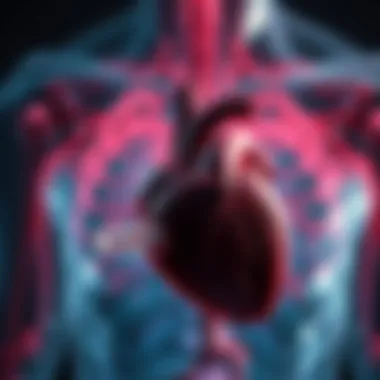

Detecting amyloid cardiomyopathy early requires a high index of suspicion and an organized approach to differential diagnosis. A comprehensive evaluation, where the entirety of clinical, laboratory, and imaging data is considered, remains the backbone of an accurate diagnosis.
As healthcare professionals navigate these complexities, ongoing education and awareness are imperative. Utilizing resources like Centers for Disease Control and Prevention or National Institutes of Health can further enhance understanding.
The ultimate goal is to ensure patients receive correct and timely diagnoses to avoid the complications of misdiagnosis and improper treatment strategies.
Implications of Diagnosis
Understanding the implications of diagnosing amyloid cardiomyopathy is crucial for guiding subsequent patient care and management. Early detection can be a game changer. The nature of this condition means that timely interventions can significantly influence a patient's quality of life and long-term prognosis. In this section, we'll dive into two core areas: prognostic considerations and strategies for managing patients following a diagnosis.
Prognostic Considerations
Prognosis in amyloid cardiomyopathy is closely tied to the promptness of diagnosis and treatment initiation. The degree of left ventricular dysfunction can serve as a vital indicator of how patients will fare over time. Individuals with an earlier diagnosis tend to respond better to treatments, and thus experience a lower risk of complications. Some critical factors influencing prognosis include:
- Type of Amyloidosis: Patients with AL amyloidosis usually have a less favorable prognosis than those with ATTR amyloidosis, especially after treatment.
- Extent of Cardiac Involvement: Affected patients’ general health and how extensively the heart is impacted can be essential in assessing long-term outcomes.
- Response to Therapy: Monitoring the efficacy of management strategies over time can provide insights into disease progression.
In sum, understanding these aspects is paramount not only for clinicians but also for patients, as these insights foster a more informed patient experience and centered care.
"The right diagnosis is not just the beginning of treatment but the foundation of the patient's journey toward health."
Patient Management Strategies
Once amyloid cardiomyopathy is diagnosed, clinicians must employ a comprehensive approach to patient management. Various strategies can be implemented to address the unique challenges faced by these patients:
- Multidisciplinary Care Team: Collaborating with cardiologists, hematologists, and primary care physicians can enhance treatment efficacy. This collaboration ensures a holistic overview of the patient's needs.
- Medication Management: Appropriate medications must be prescribed to manage symptoms and slow disease progression. For instance, heart failure treatments may be tailored to the individual’s unique cardiac profile.
- Monitoring and Follow-Up: Regular check-ups are essential to track changes in cardiac function and adjust treatment as needed. Follow-up can include echocardiograms and blood tests to gauge biomarkers.
- Patient Education and Support: Guiding patients through their condition fosters empowerment and active participation in their care. Offering resources and support groups can prove valuable for emotional and practical challenges.
- Lifestyle Modifications: Recommending tailored lifestyle changes, such as dietary adjustments and exercise plans, can also yield positive results. Every little bit helps in managing symptoms effectively.
By implementing these robust management strategies, healthcare providers may improve outcomes for those living with amyloid cardiomyopathy, addressing both clinical and emotional needs. It's not just about treating the disease, but enhancing overall well-being.
Current Challenges in Diagnosis
Diagnosing amyloid cardiomyopathy presents various hurdles that impact patient outcomes. As the disease is often insidious in nature, misdiagnosis or late diagnosis continues to be a common concern. Addressing the challenges regarding awareness among healthcare professionals, as well as the limitations of current diagnostic tools, is crucial in improving the situation.
Awareness Among Healthcare Professionals
One of the most significant barriers in the timely diagnosis of amyloid cardiomyopathy is the variability in awareness amongst healthcare professionals. While the condition has increasingly gained recognition, many clinicians still cite its rarity as a reason for the potential oversight. This can lead to a scenario where symptoms are misattributed to more common conditions like hypertension or heart failure.
Additionally, specialists in non-cardiac fields may not fully grasp the implications of amyloidosis, resulting in a delayed diagnosis. Conversations around the importance of continued education in this field of cardiology cannot be overstated. Engaging healthcare providers through structured educational campaigns can promote a better understanding of clinical signs and risk factors. Here are some approaches that may foster better awareness:
- Continuous Medical Education Programs: Regular workshops and seminars focused on amyloid cardiomyopathy could provide valuable insights and tools for recognition.
- Interdisciplinary Collaboration: Enhancing communication between various specialties—like cardiology, oncology, and hematology—can ensure a more comprehensive approach toward patient evaluation.
- Incorporating Case Studies in Training: Bringing real-world scenarios into educational institutions can aid future generations of healthcare providers in recognizing the nuances of this condition.
Culmination
Discussing the conclusion of our exploration into amyloid cardiomyopathy diagnosis brings the entire narrative full circle. Through careful examination of the diagnostic nuances of this challenging condition, we shine a light on why early and accurate diagnosis is vital.
It becomes evident that understanding the complex interplay between symptoms, risk factors, and diagnostic tools lays a strong foundation for effective patient management. Key takeaways from the article include the significance of multimodal imaging techniques such as echocardiography, cardiac MRI, and nuclear imaging, alongside the critical role played by serum biomarkers like Troponins and Natriuretic Peptides.
Moreover, awareness of the differential diagnoses that can mimic amyloid cardiomyopathy is crucial—it can be a real challenge to distinguish this condition from others. Clinicians must be equipped with knowledge and tools that help them navigate these complexities, ensuring that patients receive timely care.
"The art of medicine consists of amusing the patient while nature cures the disease."
— Voltaire
As we've seen, the implications of diagnosis extend further than immediate clinical decisions; they speak volumes about the overall prognosis and patient outcomes. This further underscores the need for continual education and awareness among healthcare professionals. The daunting challenges—ranging from diagnostic ambiguities to limitations in the tools available—necessitate a collaborative effort among researchers, clinicians, and patients alike.
In summary, this article serves not just to inform but to rally a call to action. The better we understand amyloid cardiomyopathy and its diagnosis, the brighter the prospects for improving patient care. In a field that is ever-evolving, staying informed and adept at recognizing the signs and symptoms will ultimately lead to better health outcomes for those affected.
For further insights into amyloid cardiomyopathy and ongoing research, please visit American Heart Association, and explore resources on NIH for a deeper understanding of this intricate condition.







